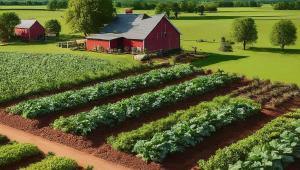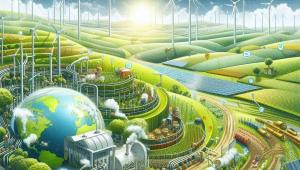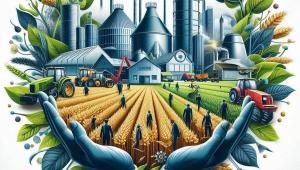Innovation has been a driving force in agriculture throughout history, from the development of early tools and techniques for cultivation and domestication to the modern applications of biotechnology, precision agriculture, and digital technologies. Innovation in agriculture has enabled farmers to increase productivity, reduce costs, improve quality, and adapt to changing environmental, social, and economic conditions.
Concepts and Types of Agricultural Innovation
Agricultural innovation can be defined as the process of developing and applying new or improved products, processes, or services to create value in the food and agriculture sector. Innovation in agriculture can take many forms and can be classified based on different criteria, such as the source, domain, or impact of innovation.
Sources of Agricultural Innovation
Agricultural innovation can come from various sources, including:
- Public research and extension systems: Public institutions such as universities, research centers, and extension agencies play a key role in generating and disseminating agricultural knowledge and technologies, particularly for public goods such as environmental conservation and food security.
- Private sector: Private companies, from small startups to large agribusiness firms, are increasingly investing in agricultural research and development to create new products and services for farmers and consumers, such as improved seeds, fertilizers, and digital tools.
- Farmers and local communities: Farmers and local communities have a wealth of traditional knowledge and experience in agriculture, and can be important sources of grassroots innovation, such as new crop varieties, farming practices, and marketing strategies.
- Collaborative and open innovation: Agricultural innovation can also emerge from collaborative and open innovation models, such as innovation platforms, hackathons, and crowdsourcing, which bring together diverse actors to co-create and share knowledge and solutions.
Domains of Agricultural Innovation
Agricultural innovation can occur in different domains or aspects of the food and agriculture system, including:
- Production: Innovations in production can include new crop varieties, animal breeds, and farming practices that increase yield, quality, and resilience, such as drought-tolerant crops, precision livestock farming, and conservation agriculture.
- Processing and distribution: Innovations in processing and distribution can include new technologies and business models that add value, reduce waste, and improve efficiency in the food supply chain, such as food processing and packaging, cold chain logistics, and e-commerce platforms.
- Consumption and nutrition: Innovations in consumption and nutrition can include new food products, diets, and behaviors that promote health, sustainability, and social equity, such as plant-based proteins, personalized nutrition, and food education programs.
- Institutional and policy: Innovations in institutions and policies can include new governance arrangements, financing mechanisms, and regulatory frameworks that create an enabling environment for agricultural innovation, such as innovation funds, standards and certifications, and multi-stakeholder partnerships.
Impacts of Agricultural Innovation
Agricultural innovation can have various impacts on different aspects of the food and agriculture system, including:
- Economic impacts: Innovations can create economic value by increasing productivity, reducing costs, and creating new markets and jobs in the agriculture sector, as well as generating spillover effects in other sectors such as food processing, retail, and services.
- Environmental impacts: Innovations can have positive or negative impacts on the environment, depending on their design and application. For example, innovations that promote sustainable intensification, such as precision agriculture and agroecology, can reduce the environmental footprint of agriculture, while innovations that rely on heavy use of inputs and resources can exacerbate environmental problems such as soil degradation, water pollution, and biodiversity loss.
- Social impacts: Innovations can have social impacts by changing the distribution of benefits and costs among different actors in the food and agriculture system, such as farmers, workers, consumers, and communities. Innovations that are inclusive, equitable, and responsive to the needs and priorities of marginalized groups can contribute to social justice and empowerment, while innovations that are exclusive, unequal, and top-down can exacerbate social inequalities and vulnerabilities.
Trends and Drivers of Agricultural Innovation
Agricultural innovation is shaped by various trends and drivers that are changing the context and incentives for innovation in the food and agriculture sector. Some of the key trends and drivers of agricultural innovation include:
Population Growth and Changing Diets
The world's population is expected to reach 9.7 billion by 2050, with most of the growth occurring in developing countries. At the same time, rising incomes, urbanization, and globalization are changing dietary patterns, with increasing demand for animal-source foods, processed foods, and convenience foods. These trends are putting pressure on the food and agriculture system to increase production, diversify diets, and reduce environmental impacts, creating new opportunities and challenges for agricultural innovation.
Climate Change and Environmental Degradation
Climate change and environmental degradation are major threats to agriculture, with impacts such as rising temperatures, changing precipitation patterns, and increasing frequency and intensity of extreme weather events. Agriculture is also a significant contributor to greenhouse gas emissions, land use change, and biodiversity loss. These trends are driving the need for agricultural innovations that can adapt to and mitigate the impacts of climate change, conserve and restore natural resources, and promote sustainable and resilient food systems.
Technological Advances and Digitalization
Rapid advances in science and technology, such as biotechnology, nanotechnology, and information and communication technologies (ICTs), are creating new opportunities for agricultural innovation. In particular, the digitalization of agriculture, also known as Agriculture 4.0, is transforming the way farmers and other actors in the food and agriculture system collect, analyze, and use data to inform decision-making and optimize performance. Digital technologies such as precision agriculture, remote sensing, and blockchain are enabling new business models, services, and governance arrangements in the agriculture sector.
Changing Consumer Preferences and Values
Consumer preferences and values are shifting towards healthier, more sustainable, and more ethical food choices, driven by factors such as increasing awareness of the links between diet, health, and the environment, as well as concerns about social justice, animal welfare, and food safety. These trends are creating new market opportunities for agricultural innovations that can deliver on these values, such as organic and regenerative agriculture, plant-based and alternative proteins, and fair trade and local food systems.
Policy and Institutional Reforms
Policy and institutional reforms are shaping the enabling environment for agricultural innovation, by creating incentives, regulations, and support mechanisms for different types and sources of innovation. For example, policies such as research and development funding, intellectual property rights, and innovation prizes can stimulate private sector investment in agricultural innovation, while policies such as extension services, farmer organizations, and innovation platforms can support public and collaborative innovation. Institutional reforms such as decentralization, privatization, and multi-stakeholder governance can also influence the distribution of power and resources in the innovation system.
Examples and Case Studies of Agricultural Innovation
To illustrate the diversity and potential of agricultural innovation, we present three examples and case studies from different regions and contexts.
System of Rice Intensification (SRI) in India
The System of Rice Intensification (SRI) is an agroecological innovation that was developed in Madagascar in the 1980s and has since spread to over 50 countries, including India. SRI is a set of management practices that can increase rice yields while reducing water, seed, and chemical inputs, by optimizing the growing conditions for rice plants. The key principles of SRI include:
- Early, quick, and healthy plant establishment
- Reduced plant density
- Improved soil conditions through organic matter additions and reduced tillage
- Reduced and controlled water application
- Increased soil aeration
- Weed control with mechanical methods
SRI has been adopted by millions of farmers in India, particularly in water-scarce and rainfed areas, and has shown yield increases of 20-50% and water savings of 25-50% compared to conventional rice cultivation. SRI has also had positive impacts on farmer livelihoods, by reducing production costs and increasing net incomes, as well as on the environment, by reducing methane emissions and improving soil health. However, SRI also faces challenges such as high labor requirements, knowledge intensiveness, and cultural barriers to adoption.
Digital Green in Africa
Digital Green is a social enterprise that uses digital technologies to amplify the reach and effectiveness of agricultural extension services in developing countries. Digital Green was founded in India in 2008 and has since expanded to over 20 countries, including several in Africa such as Ethiopia, Ghana, and Niger. The core innovation of Digital Green is a participatory video approach, where farmers are trained to create and share short videos on locally relevant agricultural practices, which are then disseminated through village-level screenings and mobile phones. The videos are supported by a data management system that tracks the reach and adoption of the practices and provides feedback to improve the content and delivery of the videos.
Digital Green has reached over 2 million farmers in Africa and has shown significant impacts on agricultural productivity, income, and nutrition. For example, in Ethiopia, Digital Green has worked with the Ministry of Agriculture and other partners to create over 1,000 videos on topics such as improved seed varieties, soil and water conservation, and nutrition-sensitive agriculture, which have been viewed by over 500,000 farmers. Evaluations have shown that farmers who watched the videos had 22% higher adoption rates of improved practices compared to non-viewers, and 14% higher crop yields. Digital Green has also had positive impacts on women's empowerment, by featuring women farmers and extension agents in the videos and promoting gender-sensitive practices.
Alternative Proteins in Europe
Alternative proteins are a growing innovation in the food and agriculture sector, aimed at providing sustainable and healthy alternatives to animal-based proteins. Alternative proteins include plant-based proteins (e.g. soy, pea, and wheat), microbial proteins (e.g. algae and fungi), and cell-based proteins (e.g. cultured meat and dairy). Europe is a leading region in the development and commercialization of alternative proteins, with a growing ecosystem of startups, investors, and research institutions.
One example of an alternative protein innovation in Europe is Quorn, a mycoprotein product derived from a fungus called Fusarium venenatum. Quorn was first developed in the UK in the 1960s and has since become a global brand, with a presence in over 20 countries. Quorn products, which include meat alternatives such as nuggets, sausages, and burgers, have a lower environmental footprint compared to animal-based proteins, with 90% less land use, 90% less water use, and 40% less carbon emissions. Quorn has also been shown to have health benefits, such as lower levels of fat and cholesterol compared to meat, and higher levels of fiber and protein compared to other plant-based alternatives.
Another example of an alternative protein innovation in Europe is Solar Foods, a Finnish startup that is developing a protein called Solein, which is produced from air, water, and electricity. Solein is a single-cell protein that is created by feeding hydrogen and carbon dioxide to a microbe called Hydrogenotroph, which is then harvested and processed into a powder that can be used as a food ingredient. Solein has a protein content of 65-70%, which is higher than most plant-based proteins, and a complete amino acid profile that is comparable to animal-based proteins. Solein also has a low environmental footprint, as it does not require land, irrigation, or fertilizers, and can be produced using renewable energy. Solar Foods is currently building its first commercial-scale factory in Finland, with a capacity to produce 50 million meals per year.
Opportunities and Challenges for Agricultural Innovation
Agricultural innovation presents both opportunities and challenges for creating sustainable, resilient, and equitable food systems. Some of the key opportunities and challenges for agricultural innovation include:
Opportunities for Agricultural Innovation
- Increasing productivity and efficiency: Innovations such as improved crop varieties, precision agriculture, and automation can increase agricultural productivity and efficiency, reducing costs and increasing incomes for farmers.
- Enhancing sustainability and resilience: Innovations such as agroecology, conservation agriculture, and climate-smart agriculture can enhance the sustainability and resilience of food systems, by conserving natural resources, reducing environmental impacts, and adapting to climate change.
- Improving nutrition and health: Innovations such as biofortification, functional foods, and personalized nutrition can improve the nutritional quality and health impacts of food, addressing malnutrition and diet-related diseases.
- Creating new markets and value chains: Innovations such as alternative proteins, e-commerce, and blockchain can create new markets and value chains for agricultural products and services, diversifying incomes and increasing access to markets for farmers and small and medium enterprises (SMEs).
- Empowering farmers and communities: Innovations such as participatory research, farmer-led innovation, and digital extension can empower farmers and communities to take ownership of the innovation process, building their capacity and agency to address their challenges and opportunities.
Challenges for Agricultural Innovation
- Unequal access and benefits: Agricultural innovations can have unequal access and benefits, particularly for small-scale farmers, women, and marginalized groups, who may lack the resources, knowledge, and power to adopt and benefit from innovations. Innovations that are not inclusive and equitable can exacerbate social and economic inequalities in the food and agriculture system.
- Environmental and health risks: Some agricultural innovations, such as genetically modified crops, agrochemicals, and intensive livestock farming, can have negative environmental and health impacts, such as loss of biodiversity, water pollution, and antibiotic resistance. Innovations that do not consider the precautionary principle and the long-term effects on ecosystems and human health can pose risks and unintended consequences.
- Concentration and consolidation: Agricultural innovations can lead to concentration and consolidation in the food and agriculture sector, with a few large companies dominating the market and the innovation process. This can reduce competition, diversity, and resilience in the food system, and limit the ability of small-scale actors to participate and benefit from innovations.
- Intellectual property and access to knowledge: Agricultural innovations are often protected by intellectual property rights, such as patents and plant variety protection, which can limit the access and use of knowledge and technologies by farmers and other actors. This can create barriers to innovation and adaptation, particularly in developing countries and for public goods such as environmental conservation and food security.
- Public trust and acceptance: Agricultural innovations can face public trust and acceptance issues, particularly when they involve new technologies or practices that are perceived as risky or unnatural, such as genetically modified organisms, nanotechnology, and cellular agriculture. Building public trust and acceptance requires transparency, participation, and communication in the innovation process, as well as consideration of the social, ethical, and cultural dimensions of innovations.
Conclusion
Innovation in agriculture is a complex and dynamic process that involves multiple actors, domains, and impacts. Agricultural innovation has the potential to create significant value for farmers, consumers, and society, by increasing productivity, sustainability, and resilience in the food and agriculture system. However, agricultural innovation also faces challenges and risks, particularly in terms of equity, access, and unintended consequences.
To harness the potential of agricultural innovation for sustainable and equitable food systems, we need to:
- Develop and promote innovations that are inclusive, participatory, and responsive to the needs and priorities of farmers and communities, particularly small-scale farmers, women, and marginalized groups.
- Invest in public research and extension systems that can generate and disseminate innovations for public goods, such as environmental conservation, food security, and social equity, and complement and collaborate with private sector and civil society innovations.
- Create enabling policies and institutions that support and incentivize different types and sources of innovations, while also ensuring transparency, accountability, and precaution in the innovation process, and protecting the rights and interests of farmers and consumers.
- Foster multi-stakeholder partnerships and platforms that bring together different actors and domains in the food and agriculture system, to co-create and share knowledge, resources, and innovations, and to address common challenges and opportunities.
- Monitor and evaluate the impacts of agricultural innovations on different aspects of sustainability, including economic, environmental, and social dimensions, and adapt and improve innovations based on learning and feedback.
Agricultural innovation is not a panacea or a silver bullet for the challenges facing the food and agriculture system, but it is an essential tool and process for creating value, adapting to change, and empowering actors. By embracing a systems approach to agricultural innovation, that recognizes the complexity, diversity, and interdependence of the food and agriculture system, we can work towards a more sustainable, resilient, and equitable future for all.










